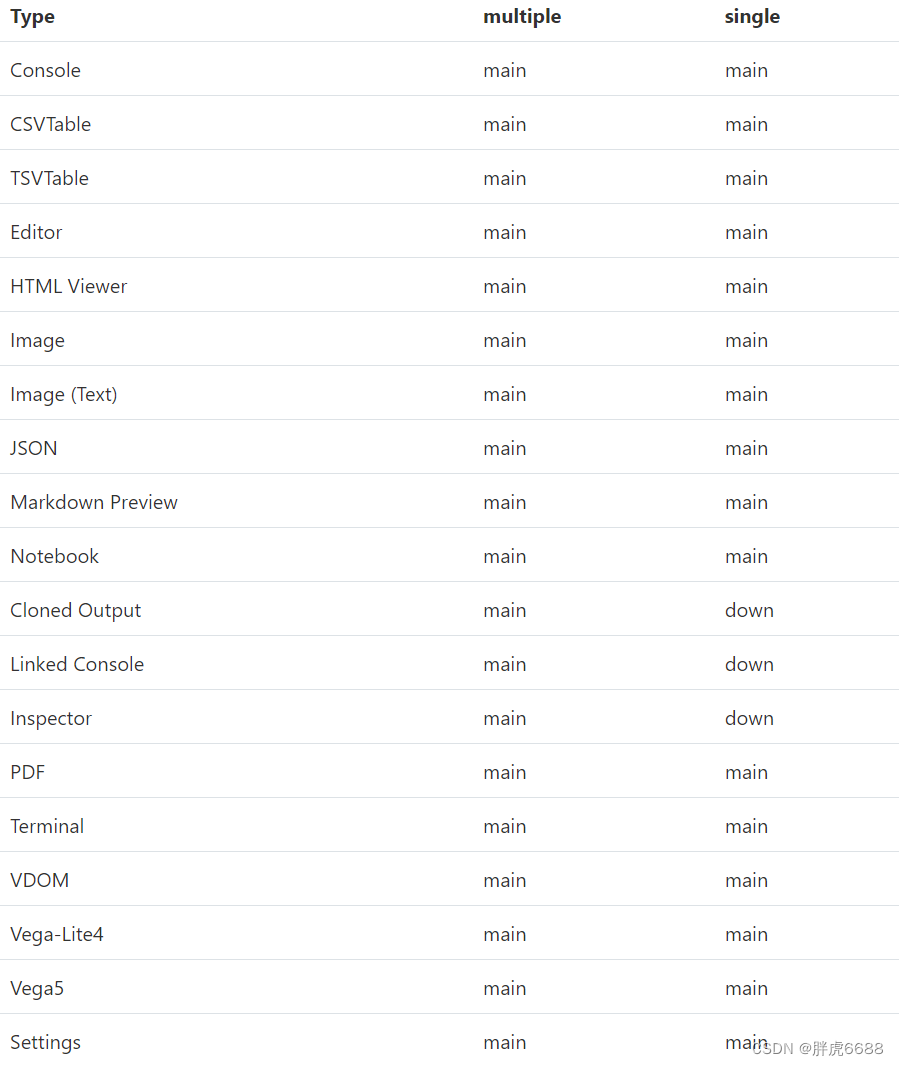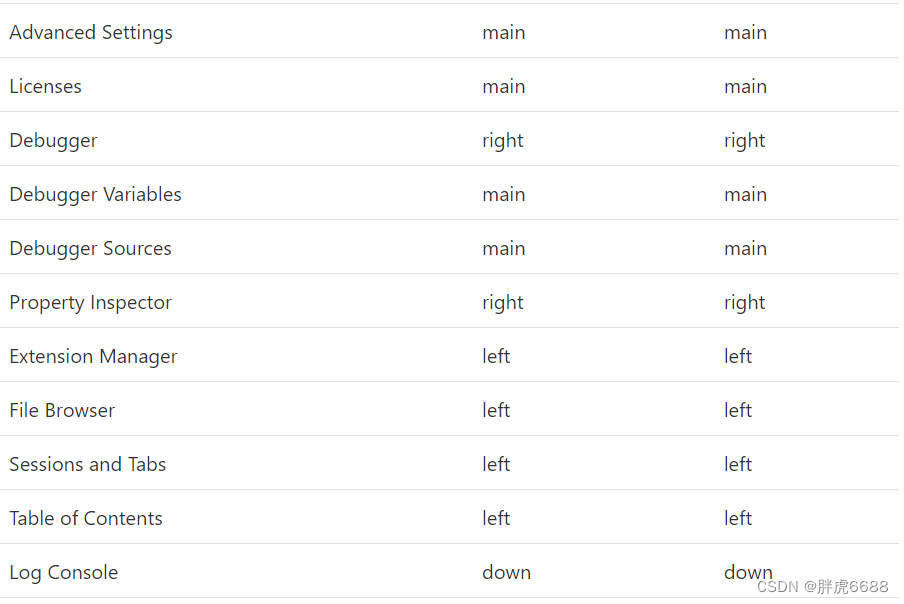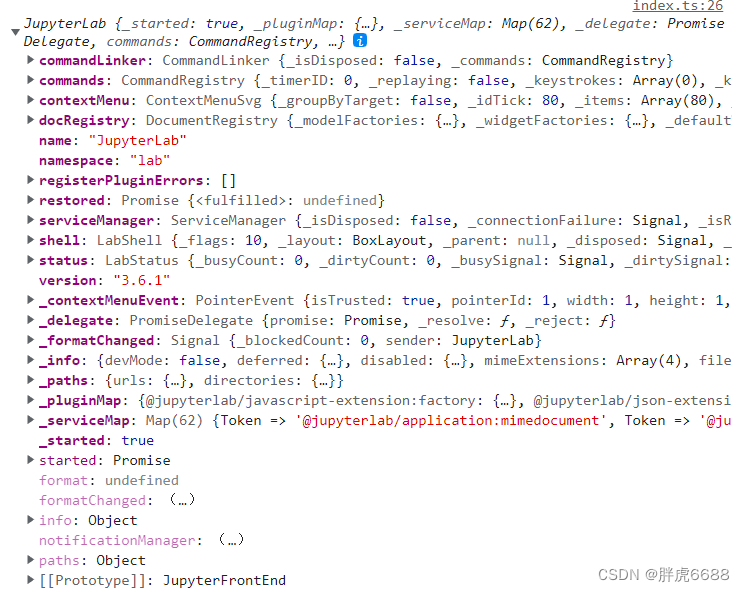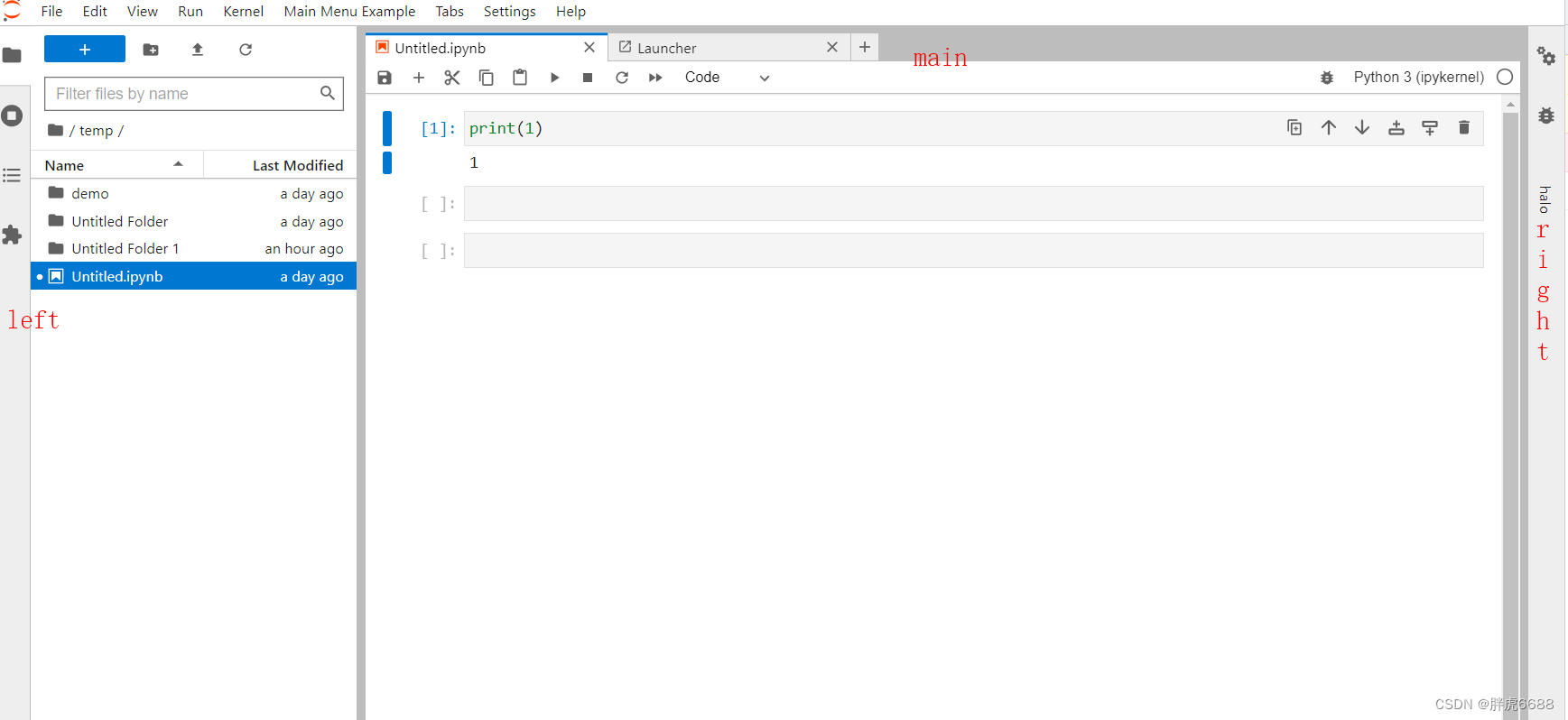简介
JupyterLab是 Jupyter的下一代基于Web的应用项目,主要用于交互开发和展示数据科学项目,写python的算法开发者、数据科学家用的较多。根据观察,使用这个技术的公司并不少。
一个 notebook 就是把代码及其输出集成到单个文档中,并且结合了可视化、叙述性文本、数学公式和其他富媒体,其实就是使用了开源的codemirror并在其基础之上进行了增强,可以在在其中运行代码、显示输出,还可以添加解释、公式、图表,并使您的工作更加透明、可理解、可重复和可共享,可简单理解为一个功能增强的代码编辑器。
首先声明,本人是前端开发,下边的内容是基于前端开发者的视角去整理的笔记,如果问题,请各位大佬多指教。下面以最新的JupyterLab为例,其内含notebook的功能,单独的notebook只是一个单独的编辑页面,JupyterLab有资源管理,并且可以自定义插件等增强的功能,对开发者来说,是一个前后端不分离的项目,后端语言是python,使用 python 写一些接口给前端通过ajax的方式调用,本人使用了axios库。
前提条件
- 编程基础,前端开发者 或 python开发者 上手会更快
- nodejs开发环境(版本不要太低)
- python开发环境(本文使用python3)
- anaconda (新手推荐,安装了这个就内置安装了好几百个python库,包括
Jupyter Notebook和JupyterLab,此文是用这个的,安装包就几百M,安装比较慢,静静等待安装好即可) - 前端界面 typescript(可选,一般是使用ts写的,也可以使用js)
开发注意事项
开发插件很容易出问题,在此列举几个常见的问题。
- 写python后端的时候,需要注意 windows 和 linux 的路径是不一样的,很容易出问题。
- 还有如果写了python代码之后,要生效,最好是现在插件开发的目录
pip install .,然后重新运行 jupyterlab。 - 如果
pip install .失败了, 把项目package.json的version字段改一下,代表插件版本更新了,然后再重新npm run build然后执行第2步,基本就好。 - 在windows开发环境下,如果删除css样式,开发环境不会删除,只能覆盖。
- 如果开发的时间长了,可能开发环境就有问题,可考虑新建conda环境,重新安装包,或者删除所有conda环境和python环境,全部重新安装,亲测有效。
- jupyterlab的版本主要注意,不同的版本开发插件的api可能不一样,有时间需要指定哪个版本进行安装
conda install jupyterlab=3.5 - 虽然支持React的开发组件的方式,但是要注意的是,只是类似React的开发,只是把React组件变成html而已,相关的生命周期并不会有逻辑的执行。
知识基础
Widget
Widget 可以理解为所有组件的父类,如果要自定义一个视图或者按钮,包括项目中的一些视图按钮等,都是继承这个类,有一些公用的方法。比如可以通过 widget.children()返回子节点、 widget.show()来显示、 widget.hide()来隐藏等,一般都是 Widget 的子类型。
import {
Widget } from '@lumino/widgets';
Widget trackers
通常扩展需要与其他扩展创建的文档和活动交互。例如,扩展可能想要将一些文本注入到笔记本单元格中,或设置自定义快捷键映射,或关闭特定类型的所有文档。这样的操作通常是由 widget trackers 完成的。扩展模块在WidgetTracker中跟踪其活动的实例,然后将其作为token提供,以便其他扩展模块可以请求它们。比如INotebookTracker ,就可以跟踪notebook的操作,增删等。
Layout 布局
JupyterLab 有两种模式,单文档模式(single)和多文档(multiple)模式,所有的widgets被放到4个区域,就是 left(左边侧边栏)、right(右边侧边栏)、main(主工作区)、down区域,可以通过基于widgets类型的设置来覆盖widgets的默认位置,在JupyterLab Shell设置。下边是所有的功能(widgets)所在的区域。


commands
可以理解为命令,就是一些封装好的功能,在某个场景触发,然后执行某些操作,例如右键执行某个操作,或者在菜单点击,实现某个操作。比如新建一个 tab 页,新建一个文本文件,打开terminal等。比如使用代码app.commands.execute("filebrowser:refresh") 来执行刷新本地文件浏览器的功能,全部的commands可以通过打印 app.commmands来找到全部的列表。
commands palette
可使用快捷键盘 ctrl + shift + c 打开,或者菜单 view => active command palette 打开,就是一堆commands的集合。

setting 界面和功能的设置
jupyterlab的 widget 的设置,包含菜单、toolbar等,都可以使用三种方式来设置。
方法1 :菜单-> setting-> Advanced Settings Editor,点击右上角的JSON Settings Editor,可以用户直接修改json的方式来配置界面项目的新增、修改、删除等。
方法2 :开发者定义,定义schema,在插件项目里,新增 schema/plugin.json,在json文件里定义,可以在代码中的 settingRegistry.schema 拿到配置。
方法3 : 开发者定义,在代码里定义。
kernel(内核)
在Jupyter体系结构中,内核是由服务器启动的单独进程,这些进程在不同的编程语言和环境中运行代码。JupyterLab能够将任何打开的文本文件连接到代码控制台和内核,可以轻松地在内核中交互地运行文本文件中的代码。了解更多。
toolbars(重要)
同样可使用3种方式来设置,第一种比较简单。可以定制toolbar的地方有,具体设置字段可以在setting菜单中查看详细字段
Cell: Cell Toolbar -> toolbar
CSV Viewer: CSV Viewer -> toolbar
File Browser: File Browser Widget -> toolbar
HTML Viewer: HTML Viewer -> toolbar
Notebook panel: Notebook Panel -> toolbar
Text Editor: Text Editor -> toolbar
TSV Viewer: TSV Viewer -> toolbar
下边为在插件中定位的json数据/schema/plugin.json, 设置 disabled 是 true 就是隐藏
"jupyter.lab.toolbars": {
"Notebook": [
{
"name": "save", "rank": 10},
{
"name": "insert", "command": "notebook:insert-cell-below", "rank": 20, "disabled": true},
{
"name": "cut", "command": "notebook:cut-cell", "rank": 21, "disabled": true },
{
"name": "copy", "command": "notebook:copy-cell", "rank": 22,"disabled": true },
{
"name": "paste", "command": "notebook:paste-cell-below", "rank": 23,"disabled": true },
{
"name": "run", "command": "runmenu:run", "rank": 30 },
{
"name": "interrupt", "command": "kernelmenu:interrupt", "rank": 31 },
{
"name": "restart", "command": "kernelmenu:restart", "rank": 32 },
{
"name": "restart-and-run", "command": "notebook:restart-run-all", "rank": 33},
{
"name": "cellType", "rank": 40 },
{
"name": "spacer", "type": "spacer", "rank": 100 },
{
"name": "kernelName", "rank": 1000 },
{
"name": "kernelStatus", "rank": 1001 }
]
},
右键 Context Menu
JupyterLab有一个应用程序范围的右键菜单,可作为app.contextMenu使用。当用户右击时,将显示应用程序右键菜单,并填充与用户单击的内容最相关的菜单项。右键菜单系统根据css选择器确定要显示哪些项目。它向上冒泡DOM树,并测试给定的HTML元素是否与给定命令提供的CSS选择器匹配。可以使用配置文件的方式,或者使用代码的方式来添加自定义的菜单项。官方文档地址
比如使用配置文件
{
"jupyter.lab.menus": {
"context": [
{
"command": "my-command",
"selector": ".jp-Notebook",
"rank": 500
}
]
}
使用代码
app.contextMenu.addItem({
command: commandID,
selector: '.jp-Notebook'
})
数据存储路径
应用程序目录:JupyterLab存储JupyterLab的主构建以及相关数据,包括构建到JupyterLab中的扩展。
用户设置目录:JupyterLab存储JupyterLab扩展的用户级别设置的目录。
工作区目录:JupyterLab存储工作区的位置
通过 jupyter lab path 命令可以得到3个路径的值。

JupyterLab还支持来自Jupyter路径层次结构中Jupyter配置目录的LabConfig子目录中的配置数据的LabConfig目录。
此外,JupyterLab可以从Jupyter数据目录的LabExtensions子目录加载动态联合(预构建)扩展,即绑定其依赖项的扩展。
插件入口 JupyterFrontEnd
import {
JupyterFrontEnd,
JupyterFrontEndPlugin
} from '@jupyterlab/application';
const plugin: JupyterFrontEndPlugin<void> = {
id: 'demo:plugin',
autoStart: true,
activate: (
app: JupyterFrontEnd,
) => {
console.log(app)
// 禁止系统右键
app.contextMenu.dispose()
}
};
export default plugin;
通过控制台打印,可以看到下面的图

这个对象几乎包含常见的使用的东西,举例,比如commands就包含所有的command的数据都在里边比如保存文件、运行文件、粘贴复制等,conextMenu包含所有的右键操作的数据在里边,shell模块 这个就很重要了,常见的界面操作在里边。
插件开发分类
JupyterLab插件是JupyterLab中可扩展性的基本单位。JupyterLab支持几种类型的插件:
应用程序插件:应用程序插件是JupyterLab功能的基本构建块。应用程序插件通过需要由其他插件提供的服务来与JupyterLab和其他插件交互,并可选地向系统提供它们自己的服务。核心JupyterLab中的应用程序插件包括主菜单系统、文件浏览器以及笔记本、控制台和文件编辑器组件。
MIME渲染器插件:MIME呈现器插件是扩展JupyterLab以在笔记本和文件中定制渲染MIME数据的简化、受限的方式。这些插件在加载时会被JupyterLab自动转换为等价的应用程序插件。核心JupyterLab中的MIME渲染器插件的例子有pdf查看器、JSON查看器和Vega查看器。
主题插件:主题插件提供了一种定制JupyterLab外观的方法,方法是更改可主题值(即,css变量值),并向JupyterLab提供额外的字体和图形。JupyterLab带有明暗主题插件。
插件开发简单流程
-
创建环境
conda create -n dev --override-channels --strict-channel-priority -c conda-forge -c nodefaults jupyterlab=3 cookiecutter nodejs jupyter-packaging git -
激活环境
conda activate dev -
生成项目
cookiecutter https://github.com/jupyterlab/extension-cookiecutter-ts -
安装依赖 前端安装好之后
pip install -ve . // 运行以下命令来安装初始项目依赖项,并将扩展安装到JupyterLab环境中。 // 上面的命令将扩展的前端部分复制到JupyterLab中。我们可以在每次进行更改时再次运行此pip安装命令,以将更改复制到JupyterLab中。 // 或者直接链接过去 jupyter labextension develop --overwrite . -
运行JupyterLab
jupyter lab // 注意,在哪个目录运行,就会加载哪个目录的文件 jupyter lab --notebook-dir=D:/myapp // 指定目录启动 jupyter lab --ServerApp.disable_check_xsrf=True --watch // 添加更多参数对前端来说,jlpm 是JupyterLab内置的类似yarn的东西。写完代码后,要生效,就立马运行
npm run build,当然可以运行 watch 命令。 -
发布开发的插件
-
也可以直接跟着 原文链接 来
插件开发常用demo合集
功能1 - 新建command添加一个页面
import {
JupyterFrontEnd,
JupyterFrontEndPlugin,
} from '@jupyterlab/application';
import {
ICommandPalette } from '@jupyterlab/apputils';
import {
Widget } from '@lumino/widgets';
const extension: JupyterFrontEndPlugin<void> = {
id: 'widgets-example',
autoStart: true,
requires: [ICommandPalette],
activate: (app: JupyterFrontEnd, palette: ICommandPalette) => {
const {
commands, shell } = app;
const command = 'widgets:open-tab';
// 使用command打开一个tab页
commands.addCommand(command, {
label: 'Open a Tab Widget',
caption: 'Open the Widgets Example Tab',
execute: () => {
const widget = new ExampleWidget();
shell.add(widget, 'main');
},
});
palette.addItem({
command, category: 'Extension Examples' });
},
};
export default extension;
class ExampleWidget extends Widget {
constructor() {
super();
this.addClass('jp-example-view');
this.id = 'simple-widget-example';
// tab页的标题
this.title.label = 'Widget Example View';
this.title.closable = true;
}
}
功能2 - 增加菜单
- 在package.json里,增加 schemaDir字段,指向我们定义的设置目录
"jupyterlab": {
"extension": true,
"outputDir": "jupyterlab_examples_main_menu/labextension",
"schemaDir": "schema"
}
- 项目新建schema目录(如果没有),新建 plugin.json,增加如下内容,通过id识别是新建菜单,还是用原来的菜单,如果是在 文件下 增加 id 就是
jp-mainmenu-file,详情内容看官网
{
"title": "Main Menu Example",
"description": "Main Menu Example settings.",
"jupyter.lab.menus": {
"main": [
{
"id": "jp-mainmenu-example-menu",
"label": "Main Menu Example",
"rank": 80,
"items": [
{
"command": "jlab-examples:main-menu",
"args": {
"origin": "from the menu"
}
}
]
}
]
},
"additionalProperties": false,
"type": "object"
}
- 配置 command
import {
JupyterFrontEnd,
JupyterFrontEndPlugin,
} from '@jupyterlab/application';
import {
ICommandPalette } from '@jupyterlab/apputils';
const extension: JupyterFrontEndPlugin<void> = {
id: 'main-menu',
autoStart: true,
requires: [ICommandPalette],
activate: (app: JupyterFrontEnd, palette: ICommandPalette) => {
const {
commands } = app;
const command = 'jlab-examples:main-menu';
commands.addCommand(command, {
label: 'Execute jlab-examples:main-menu Command',
caption: 'Execute jlab-examples:main-menu Command',
execute: (args: any) => {
console.log(
`jlab-examples:main-menu has been called ${
args['origin']}.`
);
window.alert(
`jlab-examples:main-menu has been called ${
args['origin']}.`
);
},
});
const category = 'Extension Examples';
palette.addItem({
command,
category,
args: {
origin: 'from the palette' },
});
},
};
export default extension;
功能3 - 增加tab,左右中间

import {
Widget} from '@lumino/widgets';
class ExampleWidget extends Widget {
constructor() {
super();
this.addClass('jp-example-view');
this.id = 'simple-widget-example';
this.title.label = 'halo';
this.title.closable = true;
}
}
// 往右边增加内容
const widget = new ExampleWidget();
app.shell.add(widget, 'right');
功能4 - 使用 React
首先,自行安装好 react ,如下然后就可以当做正常widget使用了
import React from "react"
import {
ReactWidget} from '@jupyterlab/apputils';
class MyComponent extends React.Component {
click = (): void => {
console.log(1111)
}
render(): React.ReactNode {
return (
<div>
<button onClick={
this.click}>hello</button>
</div>
)
}
}
// 简单创建使用
const myWidget: Widget = ReactWidget.create(<MyComponent />);
// 或者是
class DatasetWidget extends ReactWidget {
constructor() {
super();
this.addClass("jp-dataset-widget-view");
this.id = "widget-dataset";
this.title.label = ""
this.title.icon = dataIcon
this.title.caption = "数据集"
this.title.closable = false;
}
private child: DatasetComponent | undefined;
// 插件显示,要重新请求数据
protected onAfterShow() {
this.child?.loadData();
}
setChild = (v:DatasetComponent) => {
this.child = v;
}
render() {
return (
<DatasetComponent setChild={
this.setChild} />
)
}
}
功能5 - 添加一个类似插件的效果,左边增加tab和内容
import {
LabIcon } from "@jupyterlab/ui-components";
// 某段svg的代码
const pySvg =""
const pyIcon = new LabIcon({
name: "py",
svgstr: pySvg
});
// 定义这个要添加的组件
class ExampleWidget extends Widget {
constructor() {
super();
this.addClass('jp-example-view');
this.id = 'simple-widget-example';
this.title.label = '';
// 定义图标
this.title.icon = pyIcon;
this.title.caption = 'Python';
this.title.closable = true;
this.node.textContent = "this is tab content"
}
}
const plugin: JupyterFrontEndPlugin<void> = {
id: 'cybercube:plugin',
autoStart: true,
activate: (app: JupyterFrontEnd) => {
console.log('JupyterLab extension cybercube is activated!');
const widget: any = new ExampleWidget();
app.shell.add(widget, 'left');
}
};
功能6 - 在widget中使用基于svg的icon
可以在iconfont中,找到合适的svg并复制代码
import {
LabIcon } from "@jupyterlab/ui-components";
const pySvg =
`<svg t="1679991149151"
class="icon"
viewBox="0 0 1024 1024"
version="1.1"
xmlns="http://www.w3.org/2000/svg"
xmlns:xlink="http://www.w3.org/1999/xlink"
width="64"
height="64">
<path d="M943.58718 401c-15.4-61.8-44.6-108.4-106.8-108.4h-80.2v94.8c0 73.6-62.4 135.6-133.6 135.6H409.38718c-58.4 0-106.8 50-106.8 108.6v203.6c0 58 50.4 92 106.8 108.6 67.6 19.8 132.6 23.4 213.6 0 53.8-15.6 106.8-47 106.8-108.6v-81.4H516.38718v-27.2h320.4c62.2 0 85.2-43.4 106.8-108.4 22.4-67 21.4-131.4 0-217.2zM636.38718 808c22.2 0 40.2 18.2 40.2 40.6 0 22.6-18 40.8-40.2 40.8-22 0-40.2-18.4-40.2-40.8 0.2-22.6 18.2-40.6 40.2-40.6zM399.58718 496.2h213.6c59.4 0 106.8-49 106.8-108.6V183.8c0-58-48.8-101.4-106.8-111.2-71.6-11.8-149.4-11.2-213.6 0.2-90.4 16-106.8 49.4-106.8 111.2v81.4h213.8v27.2h-294c-62.2 0-116.6 37.4-133.6 108.4-19.6 81.4-20.4 132.2 0 217.2 15.2 63.2 51.4 108.4 113.6 108.4H265.98718v-97.6c0-70.6 61-132.8 133.6-132.8z m-13.4-285.2c-22.2 0-40.2-18.2-40.2-40.6 0.2-22.6 18-40.8 40.2-40.8 22 0 40.2 18.4 40.2 40.8s-18 40.6-40.2 40.6z">
</path>
</svg>`;
function iconFactory(name: string, svgstr: string): LabIcon{
return new LabIcon({
name,
svgstr
});
}
export const pyIcon = iconFactory("py", pySvg)
功能7 - 在notebook上边的头部,就是一排操作按钮下,增加一个自定义的header
import {
IDisposable, DisposableDelegate } from '@lumino/disposable';
import {
Widget } from '@lumino/widgets';
import {
JupyterFrontEnd,
JupyterFrontEndPlugin
} from '@jupyterlab/application';
import {
DocumentRegistry
} from '@jupyterlab/docregistry';
import {
NotebookPanel, INotebookModel } from '@jupyterlab/notebook';
const plugin: JupyterFrontEndPlugin<void> = {
activate,
id: 'my-extension-name:widgetPlugin',
autoStart: true
};
export class WidgetExtension implements DocumentRegistry.IWidgetExtension<NotebookPanel, INotebookModel>{
createNew(
panel: NotebookPanel,
context: DocumentRegistry.IContext<INotebookModel>
): IDisposable {
const widget = new Widget({
node: Private.createNode() });
widget.addClass('jp-myextension-myheader');
panel.contentHeader.insertWidget(0, widget);
return new DisposableDelegate(() => {
widget.dispose();
});
}
}
function activate(app: JupyterFrontEnd): void {
app.docRegistry.addWidgetExtension('Notebook', new WidgetExtension());
}
export default plugin;
namespace Private {
export function createNode(): HTMLElement {
const span = document.createElement('span');
span.textContent = 'My custom header';
return span;
}
}
css的样式
.jp-myextension-myheader {
min-height: 20px;
background-color: lightsalmon;
}
功能8 - 在启动页(Launcher),增加一个入口功能
import {
JupyterFrontEnd,JupyterFrontEndPlugin,} from '@jupyterlab/application';
import {
MainAreaWidget } from '@jupyterlab/apputils';
import {
ILauncher } from '@jupyterlab/launcher';
import {
reactIcon } from '@jupyterlab/ui-components';
import {
ReactWidget } from "@jupyterlab/apputils";
import React, {
useState } from "react";
namespace CommandIDs {
export const create = 'create-react-widget';
}
const CounterComponent = (): JSX.Element => {
const [counter, setCounter] = useState(0);
return (
<div>
<p>You clicked {
counter} times!</p>
<button
onClick={
(): void => {
setCounter(counter + 1);
}}
>
Increment
</button>
</div>
);
};
class CounterWidget extends ReactWidget {
constructor() {
super();
this.addClass("jp-ReactWidget");
}
render(): JSX.Element {
return <CounterComponent />;
}
}
const extension: JupyterFrontEndPlugin<void> = {
id: 'react-widget',
autoStart: true,
optional: [ILauncher],
activate: (app: JupyterFrontEnd, launcher: ILauncher) => {
const {
commands } = app;
const command = CommandIDs.create;
commands.addCommand(command, {
caption: 'Create a new React Widget',
label: 'React Widget',
// @ts-ignore
icon: (args) => (args['isPalette'] ? null : reactIcon),
execute: () => {
const content = new CounterWidget();
const widget = new MainAreaWidget<CounterWidget>({
content });
widget.title.label = 'React Widget';
widget.title.icon = reactIcon;
app.shell.add(widget, 'main');
},
});
if (launcher) {
launcher.add({
command,
});
}
},
};
export default extension;
功能9 - 激活某个功能(比如左边栏或者右边栏的功能)
// 通过组件功能的id来启动即可
const plugin: JupyterFrontEndPlugin<void> = {
id: 'demo:plugin',
autoStart: true,
requires: [ILayoutRestorer],
activate: (
app: JupyterFrontEnd,
restorer: ILayoutRestorer,
) => {
app.shell.activateById("widget-model-info-libs");
}
};
功能10 - 监听编辑路径变化、文件内容变化、当前编辑文件变化
import {
FileBrowserModel, IFileBrowserFactory } from '@jupyterlab/filebrowser';
import {
IChangedArgs } from '@jupyterlab/coreutils';
const plugin: JupyterFrontEndPlugin<void> = {
id: 'demo:plugin',
autoStart: true,
requires: [
ILayoutRestorer,
IFileBrowserFactory
],
activate: (
app: JupyterFrontEnd,
restorer: ILayoutRestorer,
fileBrowserFactory: IFileBrowserFactory,
) => {
// 监听路径改变
const onPathChanged = (
model: FileBrowserModel,
change: IChangedArgs<string>
) => {
console.log(model)
console.log(change)
};
fileBrowserFactory.defaultBrowser.model.pathChanged.connect(onPathChanged);
// 监听文件内容改变
const fileChange = (model: FileBrowserModel, b: any) => {
console.log(model,b)
}
fileBrowserFactory.defaultBrowser.model.fileChanged.connect(fileChange);
// 监听当前编辑文件变化
const handler = (shell: JupyterFrontEnd.IShell, data: {
newValue: string, oldValue: string}) => {
console.log(shell,data)
}
// @ts-ignore
app.shell.currentPathChanged.connect(handler)
}
}
扩展入口代码片段
各个组件库、基本的使用方法、注释
import React from "react"
import {
ILayoutRestorer,
JupyterFrontEnd,
JupyterFrontEndPlugin,
ILabStatus
// IConnectionLost,
// IInfo
// IRouter
} from '@jupyterlab/application';
import {
Widget} from '@lumino/widgets';
// import { requestAPI } from './handler';
import {
ICommandPalette,
ISplashScreen,
IThemeManager,
IToolbarWidgetRegistry,
MainAreaWidget,
WidgetTracker,
ReactWidget
} from '@jupyterlab/apputils';
import {
IDocumentManager} from "@jupyterlab/docmanager"
import {
IFileBrowserFactory} from "@jupyterlab/filebrowser"
import {
IEditorTracker} from "@jupyterlab/fileeditor"
import {
IHTMLViewerTracker} from "@jupyterlab/htmlviewer"
import {
ILauncher} from "@jupyterlab/launcher"
import {
IMainMenu} from "@jupyterlab/mainmenu"
import {
ISettingEditorTracker} from "@jupyterlab/settingeditor"
import {
ISettingRegistry} from "@jupyterlab/settingregistry"
import {
IStateDB} from "@jupyterlab/statedb"
import {
IStatusBar} from "@jupyterlab/statusbar"
import {
ITerminalTracker} from "@jupyterlab/terminal"
import {
ITooltipManager} from "@jupyterlab/tooltip"
import {
INotebookTools, INotebookTracker, INotebookWidgetFactory} from "@jupyterlab/notebook"
interface APODResponse {
copyright: string;
date: string;
explanation: string;
media_type: 'video' | 'image';
title: string;
url: string;
}
/**
* Initialization data for the cybercube extension.
*/
const plugin: JupyterFrontEndPlugin<void> = {
id: 'cybercube:plugin',
autoStart: true,
requires: [
ICommandPalette,
ISplashScreen,
IThemeManager,
IToolbarWidgetRegistry,
IDocumentManager,
IFileBrowserFactory,
IEditorTracker,
IHTMLViewerTracker,
ILauncher,
IMainMenu,
INotebookTools,
INotebookTracker,
INotebookWidgetFactory,
ISettingEditorTracker,
ISettingRegistry,
IStateDB,
IStatusBar,
ITerminalTracker,
ITooltipManager,
ILabStatus
],
optional: [ILayoutRestorer],
activate
};
export default plugin;
// @ts-ignore
// @ts-ignore
function activate(
app: JupyterFrontEnd,
palette: ICommandPalette,
splashScreen: ISplashScreen,
themeManager: IThemeManager,
// 工具栏小部件的注册表,如果要从数据定义(例如存储在设置中)动态生成工具栏,则需要此选项
toolbarWidgetRegistry: IToolbarWidgetRegistry,
// 操作文件系统,文件增删
documentManager: IDocumentManager,
// 可以自定义文件浏览器
fileBrowserFactory: IFileBrowserFactory,
// 如果希望能够循环访问由应用程序创建的文件编辑器并与之交互,请使用此选项
editorTracker: IEditorTracker,
// 处理HTML documents的交互
htmlViewerTracker: IHTMLViewerTracker,
// 添加东西到launcher
launcher: ILauncher,
mainMenu: IMainMenu,
// 在右侧边栏中notebook工具面板的服务。使用此选项可将您自己的功能添加到面板。
notebookTools: INotebookTools,
// 一种用于notebook的部件跟踪器。如果您希望能够循环访问应用程序创建的notebook并与之交互,请使用此选项。
notebookTracker: INotebookTracker,
// @ts-ignore 可以自行创建notebook
notebookWidgetFactory: INotebookWidgetFactory,
// 处理编辑器设置
settingEditorTracker:ISettingEditorTracker,
// jupyterlab 设置系统,可以存储应用的存储设置
settingRegistry: ISettingRegistry,
// jupyterlab的状态数据库
stateDB: IStateDB,
// 状态栏的操作
statusBar: IStatusBar,
// 控制台的操作
terminalTracker: ITerminalTracker,
tooltipManager: ITooltipManager,
labStatus: ILabStatus,
restorer: ILayoutRestorer | null
) {
console.log('JupyterLab extension jupyterlab_apod is activated!');
// Declare a widget variable
let widget: any;
// console.log(app);
// console.log(splashScreen);
// console.log(themeManager);
// splashScreen.show(true)
// toolbarWidgetRegistry.createWidget
// console.log(documentManager)
/**
* @title 添加普通节点到 文件浏览器 toolbar
*/
// const t = fileBrowserFactory.defaultBrowser.toolbar;
// const w: any = new Widget();
// w.node.textContent = "haha"
// t.addItem("haha", w);
/**
* @title 添加react节点到 文件浏览器 toolbar
*/
// const t = fileBrowserFactory.defaultBrowser.toolbar;
// class MyComponent extends React.Component {
// click = (): void => {
// console.log(1111)
// }
// render(): React.ReactNode {
// return (
// <div>
// <button onClick={this.click}>hello</button>
// </div>
// )
// }
// }
// // @ts-ignore
// const myWidget: Widget = ReactWidget.create(<MyComponent />);
// // @ts-ignore
// t.addItem("ff", myWidget);
/**
* @title fileBrowserFactory
*/
// const fb = fileBrowserFactory.createFileBrowser("custom-browser")
// console.log(fb)
// ----- fileBrowserFactory ------
// 默认文件浏览器的dom
// console.log(fileBrowserFactory.defaultBrowser.node)
// 默认文件浏览器上边那三个按钮
// console.log(fileBrowserFactory.defaultBrowser.toolbar.node)
// 文件列表的dom
// console.log(fileBrowserFactory.defaultBrowser.listing.node)
// 文件列表上边的path的dom
// console.log(fileBrowserFactory.defaultBrowser.crumbs.node)
// ----- fileBrowserFactory ------
// console.log(editorTracker);
// console.log(htmlViewerTracker);
// console.log(launcher);
// console.log(notebookTools);
// console.log(notebookTracker);
// console.log(notebookWidgetFactory);
// console.log(settingEditorTracker);
// console.log(settingEditorTracker.currentWidget);
// console.log(stateDB);
// stateDB.save("myid", "cube").then(r => {
// console.log(r);
// }).catch(e => {
// console.log(e);
// })
// stateDB.fetch("myid").then(r => {
// console.log(r);
// })
// console.log(terminalTracker);
// terminalTracker.forEach(e => {
// console.log(e);
// })
// console.log(tooltipManager.invoke());
// 自定义添加右键菜单,根据css选择器匹配在什么地方出现,甚至可以自定义右键菜单
// console.log(app.contextMenu)
// console.log(app)
// 可以添加widgets到应用中
// A top area for things like top-level toolbars and information.
// A menu area for top-level menus, which is collapsed into the top area in multiple-document mode and put below it in single-document mode.
// left and right sidebar areas for collapsible content.
// A main work area for user activity.
// A down area for information content; like log console, contextual help.
// A bottom area for things like status bars.
// A header area for custom elements.
// console.log(app.shell.add());
// 添加快捷键
// Accel 就是 ctrl
// app.commands.addKeyBinding({
// command: commandID,
// args: {},
// keys: ['Accel T'],
// selector: '.jp-Notebook'
// });
// launcher.add({
// command: 'apod:open',
// category: 'Tutorial',
// rank: 0
// });
// setTimeout(() => {
// app.commands
// .execute('terminal:create-new')
// .then((terminal: any) => {
// app.shell.add(terminal, 'right');
// });
// }, 2000)
const command: string = 'open-picture';
/**
* @title 菜单操作,暂没作用
*/
// console.log(mainMenu.addMenu);
/// @ts-ignore
// const menu = new Menu({ "commands": app.commands });
// menu.addItem({
// command,
// args: {},
// });
// mainMenu.addMenu(menu as any, { rank: 40 });
// 成功了,可以跑,在文件菜单下增加子项
mainMenu.fileMenu.addGroup([ {
command}], 40);
/**
* @title 状态栏的操作
*/
// console.log(statusBar);
const statusWidget = new Widget();
labStatus.busySignal.connect(() => {
statusWidget.node.textContent = labStatus.isBusy ? 'Busy' : 'Idle';
});
statusBar.registerStatusItem('lab-status', {
align: 'middle',
// @ts-ignore
item: statusWidget
});
// console.log(notebookTracker)
app.commands.addCommand(command, {
// command 的标题
label: 'Astronomy Picture',
execute: () => {
if (!widget || widget.isDisposed) {
const content: any = new APODWidget();
widget = new MainAreaWidget({
content});
widget.id = 'apod-jupyterlab';
// 页面tab的标题
widget.title.label = '太空图片';
widget.title.closable = true;
}
if (!tracker.has(widget)) {
// Track the state of the widget for later restoration
tracker.add(widget);
}
if (!widget.isAttached) {
// Attach the widget to the main work area if it's not there
app.shell.add(widget, 'main');
}
widget.content.updateAPODImage();
// Activate the widget
app.shell.activateById(widget.id);
}
});
// Add the command to the palette.
palette.addItem({
command, category: 'Tutorial' });
// Track and restore the widget state
let tracker: any = new WidgetTracker({
namespace: 'apod'
});
if (restorer) {
restorer.restore(tracker, {
command,
name: () => 'apod'
});
}
}
class APODWidget extends Widget {
/**
* Construct a new APOD widget.
*/
constructor() {
super();
this.addClass('my-apodWidget');
// Add an image element to the panel
this.img = document.createElement('img');
this.node.appendChild(this.img);
// Add a summary element to the panel
this.summary = document.createElement('p');
this.node.appendChild(this.summary);
}
/**
* The image element associated with the widget.
*/
readonly img: HTMLImageElement;
/**
* The summary text element associated with the widget.
*/
readonly summary: HTMLParagraphElement;
/**
* Handle update requests for the widget.
*/
async updateAPODImage(): Promise<void> {
const response = await fetch(`https://api.nasa.gov/planetary/apod?api_key=DEMO_KEY&date=${
this.randomDate()}`);
if (!response.ok) {
const data = await response.json();
if (data.error) {
this.summary.innerText = data.error.message;
} else {
this.summary.innerText = response.statusText;
}
return;
}
const data = await response.json() as APODResponse;
if (data.media_type === 'image') {
// Populate the image
this.img.src = data.url;
this.img.title = data.title;
this.summary.innerText = data.title;
if (data.copyright) {
this.summary.innerText += ` (Copyright ${
data.copyright})`;
}
} else {
this.summary.innerText = 'Random APOD fetched was not an image.';
}
}
/**
* Get a random date string in YYYY-MM-DD format.
*/
randomDate(): string {
const start = new Date(2010, 1, 1);
const end = new Date();
const randomDate = new Date(start.getTime() + Math.random()*(end.getTime() - start.getTime()));
return randomDate.toISOString().slice(0, 10);
}
}
相关链接
- 在线试用jupyter
- Jupyter Notebook介绍、安装及使用教程
- Anaconda介绍、安装及使用教程、Anaconda官网
- anaconda的卸载与重装、深度学习相关配置
- python最详细的安装与完全卸载
- 开发插件文档入口、 扩展开发接口列表
- jupyter-notebook 官方文档
- 插件生成 extension-cookiecutter-ts
- JupyterLab API Documentation
- 扩展demo合集-新手必看
- jupyterlab-git – jupyterlab的git插件,很好的学习作用
- lumino、 conda-forge
- codemirror (开源代码编辑器)
- conda创建环境报错,CondaSSLError: OpenSSL appears to be unavailable on this machine. OpenSS…
